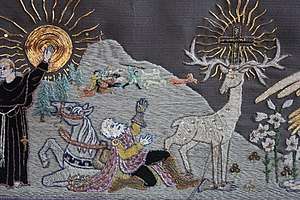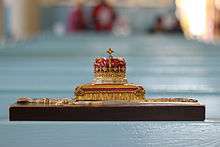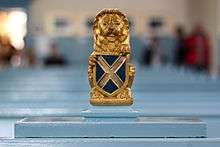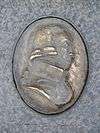Kirk of the Canongate
| Kirk of the Canongate | |
|---|---|
|
| |
| Location | Canongate, Edinburgh |
| Country | Scotland |
| Denomination | Church of Scotland |
| History | |
| Status | Parish church |
| Architecture | |
| Functional status | Active |
| Years built | 1688–1691 |
| Clergy | |
| Minister(s) | The Revd Neil N. Gardner |
The Kirk of the Canongate, or Canongate Kirk, serves the Parish of Canongate in Edinburgh's Old Town, in Scotland. It is a congregation of the Church of Scotland. The parish includes the Palace of Holyroodhouse and the Scottish Parliament. It is also the parish church of Edinburgh Castle, even though the castle is detached from the rest of the parish. The wedding of Zara Phillips, the Queen's granddaughter, and former England Rugby Captain, Mike Tindall, took place at the church on 30 July 2011.[1]
Canongate
The Canongate was a separate burgh before it was formally absorbed by Edinburgh in 1856. By the late 1970s, the lower part of the Royal Mile, including the Canongate, had become unfashionable and run down. The local population was declining. The Kirk was threatened with closure, which was successfully resisted by the minister and congregation. Since then, circumstances have changed radically - notably with the construction of new flats in the vicinity as well as the new Scottish Parliament building.
The building and kirkyard



The church was founded in 1688 and completed in 1691. The master mason in charge was James Smith. A plaque on the front of the church bears witness to it having been built through a large bequest from a local merchant:
"In 1688 King James VII ordained that the Mortification of Thos. Moodie, granted in 1649 to build a Church, should be applied to the erection of this structure"
(In this quotation, the word Mortification is an historic term from Scottish Law meaning "the disposal of property for religious or (since the Reformation) other charitable or public purposes, or a document embodying this".)[2]
Previously the residents of the Canongate had used the Abbey Church adjacent to the Palace of Holyroodhouse, but King James VII ordered the construction of the new Kirk of the Canongate, allowing the Abbey Church to be converted into a Chapel for the Order of the Thistle. (The current Thistle Chapel is attached to St Giles' Cathedral).
Architecturally, the Kirk has a Dutch-style end gable and a curious, small doric-columned portico over the entrance. The end gable is topped with a golden cross inside a pair of antlers, the now obsolete coat of arms of the Canongate, first placed on the apex of the roof in 1824 and replaced by those from a stag shot at Balmoral by King George VI in 1949. The Kirk's interior has a cruciform layout (highly unusual for a post-Reformation, pre-Victorian Church of Scotland building). The Kirk's interior was extensively remodelled in 1882, with the inclusion of a pipe organ and a central pulpit. These unsympathetic alterations were removed in the early 1950s, along with the galleries. The resulting reordering considerably increased the levels of light; the original dignified simplicity of the Kirk was able to be appreciated once more. The Kirk was further restored in 1991 by the Stewart Todd partnership, followed by the installation of a new Danish-built Frobenius pipe organ in 1998, in memory of the late Very Rev Dr Ronald Selby Wright. This was the 1000th organ to be built by the Frobenius company.
Following the Disruption of 1843, a Holyrood Free Church congregation was formed. A church was built in front of the Palace of Holyroodhouse, but the building was closed in 1915 (when that congregation united with Abbeyhill United Free Church, becoming Holyrood Abbey Church, located in London Road.) The former Holyrood Free Church building was reopened as The Queen's Gallery in 2003, to house exhibitions from the Royal Collection. A Royal Pew as well as a Castle Pew can be found in the front row of the church.



The Canongate Churchyard is the resting place of several Edinburgh notables including the economist Adam Smith, the philosopher and Smith's biographer Dugald Stewart, Agnes Maclehose (the "Clarinda" of Robert Burns), by tradition David Rizzio, the murdered private secretary of Mary, Queen of Scots, and the poet Robert Fergusson, whose statue in bronze by David Annand stands outside the kirk gate. Bishop James Ramsay is also buried here.
Current work
The Kirk has an active congregation, conducting two worship services each Sunday. A family service at 10 am lasting about half an hour is conducted from the King David aisle, the right hand side of the Kirk. During this service, children of all ages enjoy their own stories and activities in the Sunday School. The more formal Parish Worship begins at 11:15 am. This service lasts just under an hour and follows a set liturgy. The Sacrament of Holy Communion is usually celebrated on the last Sunday of the month at the Parish Worship service. The building is also regularly used for concerts. During the annual Edinburgh Festival, the Kirk is extensively used as a venue for music, as is the Kirk's nearby hall - the "Harry Younger Hall" (which is known as "Venue 13" for the duration of the annual Edinburgh Festival Fringe; Venue 13 is run by the Royal Welsh College of Music & Drama). The Kirk was previously the regimental chapel of The Royal Scots Regiment of the British Army and is now the regimental chapel of The Royal Regiment of Scotland.
Ministry
Canongate Kirk has been served by several well-known former ministers, two having also served as Moderator of the General Assembly of the Church of Scotland. Very Rev Thomas Wilkie (1645-1711) was the first minister of the Kirk and was twice Moderator - in 1701 and 1704. A long family tradition started in the 18th century with three generations of minister taking the ministry, all Rev John Warden the family changed its name to Macfarlan in the later 18th century following a marriage. The most notable,Rev John Warden (Macfarlan) (1740-1788) was minister 1762 to 1788 and co-founded the Royal Society of Edinburgh in 1783.[3]
Rev Hugh Blair was first in charge from 1745 to 1753, following two years as second in charge.
During these early years ministries were shared due to demand. Concurrently with Rev John Warden (from 1764 to 1783) Rev William Lothian DD (1740-1783) was First Charge.
The Very Reverend Dr Ronald Selby Wright, known as the "Radio Padre" for his famous wartime broadcasts, was minister from 1937 until 1977 and served as Moderator in 1972. Whilst Dr Selby Wright was away on wartime service as an Army Chaplain, the Revd George MacLeod (later the Very Revd Lord MacLeod of Fuinary, founder of the Iona Community and Moderator in 1957) served as locum. Dr Selby Wright was succeeded as minister by the Reverend Charles Robertson LVO MA, who retired in 2005.
The current minister (since 22 June 2006) is the Reverend Neil N. Gardner MA BD (who was previously minister at Alyth and an Army Chaplain in the Black Watch Regiment). The organist and Director of Music is David Goodenough, also Director of Music at Fettes College in Edinburgh. The Kirk Secretary and Events Administrator is Imogen Gibson who works from the Manse office. Canongate Kirk has a small but thriving Sunday School that takes place at the 10 am Family Service.
Other notable ministers were Rev John Warden (1709-1764), his son, Rev John Warden of Ballancleroch FRSE (1740-1788), a joint founder of the Royal Society of Edinburgh[4], and his grandson Rev John Warden of Kirkton (1767-1846). The family changed their surname to McFarlan in 1767. A remarkable three generations in the same role.
See also
References
- ↑ "Zara Phillips and Mike Tindall set wedding date". BBC News. 9 March 2011.
- ↑ Oxford English Dictionary (online)
- ↑ Biographical Index of Former Fellows of the Royal Society of Edinburgh 1783–2002 (PDF). The Royal Society of Edinburgh. July 2006. ISBN 0 902 198 84 X.
- ↑ Biographical Index of Former Fellows of the Royal Society of Edinburgh 1783–2002 (PDF). The Royal Society of Edinburgh. July 2006. ISBN 0 902 198 84 X.
External links
| Wikimedia Commons has media related to Canongate Kirk. |
- Canongate Kirk
- Church of Scotland
- Kirk's captain boldly goes after 27 years (Retirement of the Reverend Charles Robertson) - The Scotsman, 20 Sept 2005
- Profile of the Revd Neil Gardner - Edinburgh Evening News, 18 April 2006
- Venue 13 (The Harry Younger Hall)
- Venue 13 (BBC Wales news)
- Canongate Kirk's pipe organ - Th. Frobenius og Sønner Orgelbyggeri A/S (in Danish)
- Edinburgh Architecture - The Royal Mile (with original drawing of Canongate Kirk)